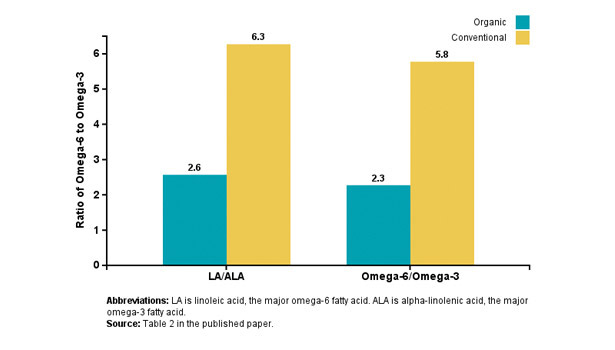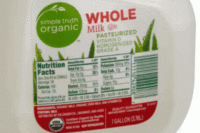Our 18-month nationwide study confirms that there are large and consistent differences in the fatty acid profile of organic and conventional milk and dairy products in the United States. Samples of organic and conventional whole milk from 14 dairy processors in seven regions were tested once a month for 18 months, producing by far the most extensive comparative survey ever conducted in the United States.
The key goal in this study was to estimate whether, and the degree to which, organic dairy products can improve health outcomes through changes in the fatty acid profile of milk.
Many people have asked why the team focused on the balance of fatty acids in milk. Over many centuries, the pre-historic human diet likely contained roughly equal amounts of omega-6 and omega-3 fatty acids, and hence humans evolved with a omega-6/omega-3 ratio near 1.0.
Today, most Americans consume 10 to 15 grams of omega-6 fatty acid for each 1 gram of omega-3. This is largely due to high consumption of fried foods and vegetable oils containing substantial levels of omega-6 fatty acids, such as soy, corn, cottonseed and safflower oils.
Although the optimal omega-6/omega-3 ratio depends on the health measure in question and genetic factors, there is some consensus that the omega-6/omega-3 ratio should be lowered to about 2.3 to minimize the risk of cardiovascular disease—a benchmark and target used in our PLOS ONE study.
Key findings of the research
The organic whole milk had 62% more total omega-3 fatty acids than conventionally produced milk. Among individual omega-3 fatty acids, organic milk concentrations were 60% higher for ALA (alpha-linolenic acid), 33% higher for EPA (eicosapentaenoic acid), and 18% higher for DPA (docosahexaenoic acid).
In addition, organic whole milk had 25% lower total omega-6 fatty acids, and 25% lower concentration of LA (linolenic acid), the major omega-6 fatty acid.
Last, organic whole milk had, on average year round, 18% higher levels of another heart-healthy fatty acid called CLA (conjugated linoleic acid) than conventional milk.
Both organic and conventional milk and dairy products help lower the key omega-6/omega-3 ratio. The average omega-6/omega-3 ratio found in this study for one brand of organic milk is 2.3, while in conventional milk the average ratio is 5.7, still substantially better than most sources of fat in the American diets.
The omega-6/omega-3 ratio in organic milk is much lower than in conventional milk, because pasture and forage-based feeds make up a much greater share of daily “dry matter intake” on organic dairy farms, compared to conventional dairy farms. Conventional dairy farmers who provide cows access to lush pasture and high-quality forage-based feeds, coupled with relatively less corn and corn silage, can also shift the fatty acid profile of milk, in the same way and for the same reasons as on organic farms.
We also report that simple steps by consumers can markedly lower an individual’s overall dietary omega-6/omega-3 intake ratio. The team estimated fatty acid intakes in hypothetical diet scenarios, focusing on a moderately active 30-year old woman, who had an omega-6/omega-3 ratio of 11.3 in the baseline scenario.
All milk is good for you, but organic whole milk is even better.
Milk and dairy products are an excellent and affordable source of many essential nutrients and full-fat forms also contain a much healthier balance of omega-3 and omega-6 fatty acids than other major sources of fat. Omega-3 fatty acids help balance inflammation, promote heart health and are critical for the healthy development of infants and children.
Key insight: feed matters
Grass in dairy cow diets improves the nutritional quality of milk.
Organic farmers rely much more heavily than conventional farmers on pasture and forage-based feeds that promote omega-3 fatty acids in milk. This is a positive benefit of organic certification programs, which set minimum requirements for pasture intakes. Dairy farmers who are heavily reliant on corn and other grain-based feeds, whether conventional or organic, will inadvertently drive upward the omega-6 fatty acids in milk, and depress omega-3 levels.
Surprisingly simple changes in food choices can lead to much better levels of the healthier fats we see in organic milk.
Just switching from a moderate consumption of conventional dairy products (three servings per day) to a higher consumption of full-fat organic dairy products (4.5 servings per day) can reduce a person’s omega-6/omega-3 ratio from around 11.3 to 7.8. This 3.5-point decline achieves 39% of the 9-point reduction needed to reach a heart-healthy target of 2.3.
By also avoiding some fried foods and condiments high in omega-6 fatty acids, a person can lower their overall omega-6/omega-3 ratio to around 4, about 80% of the reduction necessary to reach the 2.3 heart-healthy goal.
The authors also note one unexpected finding: Recommended intakes of organic whole milk is far superior to recommended fish intakes in terms of improving omega-6/omega-3 fatty acid intake ratios.
Fish meat contains relatively low levels of both LA and ALA and dietary guidelines call for only about 8 ounces of fish consumption per week (to avoid excessive heavy metal intakes). In addition, organic milk is a surprisingly good source of EPA and DPA, two of the three important, long-chain omega-3 fatty acids, EPA, DPA, and DHA. Fish remains by far the best source of the long-chain polyunsaturated fatty acid DHA.


